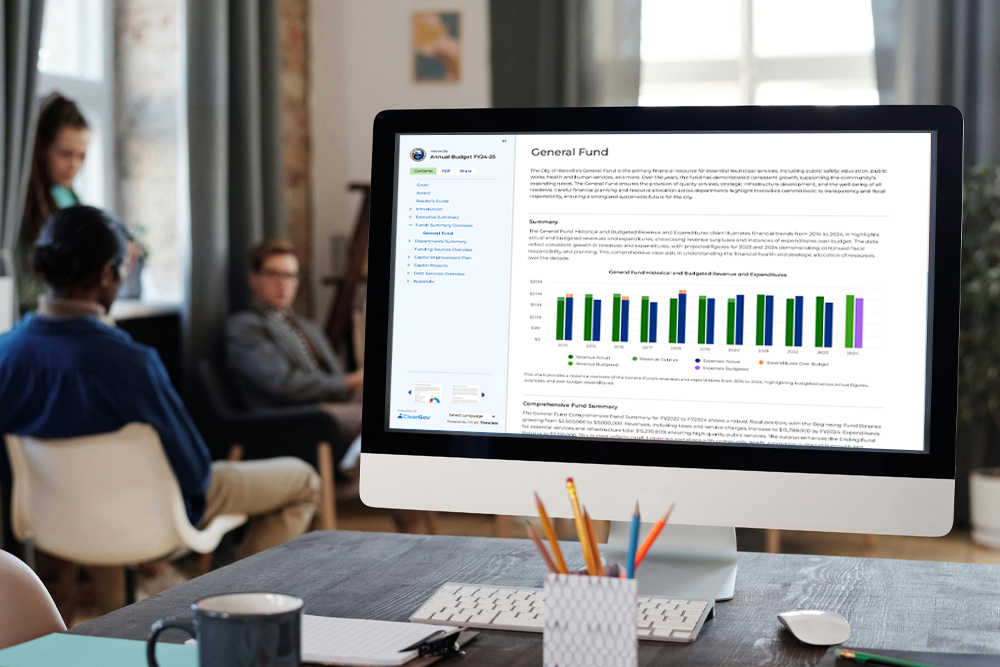Special District Leaders Share Benefits of Modernizing Their Budgeting Process Fire, water, sewer, parks & rec, and other special districts have unique needs when it comes to the annual budgeting process. These divisions’ budgets are heavy on capital projects, so they rely more on community involvement and getting buy-in from constituents. But using spreadsheets and email to forecast a multi-year, multi-scenario plan is tedious, time-consuming, and error-prone. For divisions whose town or city is already using a cloud-based budgeting solution, like ClearGov, they might be curious about purchasing the same solution for their own capital planning. Here are some of the benefits district leaders have shared with us after modernizing their budgeting process with ClearGov. Save Time & MoneyPerhaps the biggest benefit of modernizing the budgeting process is saving time. Especially when it comes to creating multi-year plans, manually manipulating data across multiple spreadsheets or tabs is just inefficient. Then you have to go back and make changes to data in multiple places anytime a figure is updated, see how that affects the rest of the budget, adjust again… rinse and repeat. When you’re ‘done,’ you spend even more time on reconciliation to make sure no formulas are broken and all of the data is rolling up correctly. District directors also find themselves spending a lot of time on the request process in a manual system. Their contributors may be submitting capital requests via paper, email, or an online form. There’s a lot of back-and-forth, and supporting documentation or communication may get lost in the shuffle. Additionally, there may be multiple meetings or phone calls to justify the project or get more details. At the end of the day, departments that are responsible for their capital improvement plans could spend hundreds of hours creating scenarios that account for different project plans, different fund sources, and all the other ‘what ifs’ that have to be factored in before a project is approved. With ClearGov Capital Budgeting, you save time and money by:
Eliminate ErrorsAny time you are manually entering, moving, or changing data, there is a risk of human error. Not only is it frustrating and time-consuming to have to check and double-check your work, but an error in the budget could have very expensive consequences. The risk of error tends to be compounded for departments that must create capital plans several years out. One error on a project cost in year 1 can snowball into subsequent years, potentially even rendering the project unfeasible by the time the error is caught. In addition to simple human error, one of the biggest concerns with spreadsheets is access control. The more cooks in the kitchen, the more likely someone is to accidentally overwrite data or delete a formula. While this can be solved by managing multiple spreadsheets for your different contributors, consolidating the data into your master sheet adds yet another opportunity for error! With ClearGov, you can eliminate human error by:
Improve Communication & Transparency With ConstituentsGetting buy-in from constituents is a key part of the budgeting process for parks & rec, water, sewer, and fire departments. You provide critical programs and services to your community, but you have to convince people that their tax dollars are best spent on certain projects. And let’s get real: new sewer lines aren’t sexy! While your division may have a bigger marketing budget and savvy marketers that know how to make sewer lines more palatable, you’re always going to be up against constituents scrutinizing your capital budget. You can improve communication and transparency through more town hall meetings, open-door policies, and publishing your capital budget PDF on your website. But all of these avenues require extra effort for constituents to find the information they’re looking for. With ClearGov, you can improve communication and transparency with constituents by:
Ultimately, all of these features and benefits make it easier for departments to collaborate internally and create their own budget. Then when they go to submit their budget to their town or city for approval, the engaging project pages and graphics make it easier for stakeholders to visualize the budget and understand how it fits with the rest of the budget — something that Excel simply can’t do! Ready to see if ClearGov’s Capital Budgeting solution makes sense for your division? Watch a quick demo today, then contact us to learn more. |












